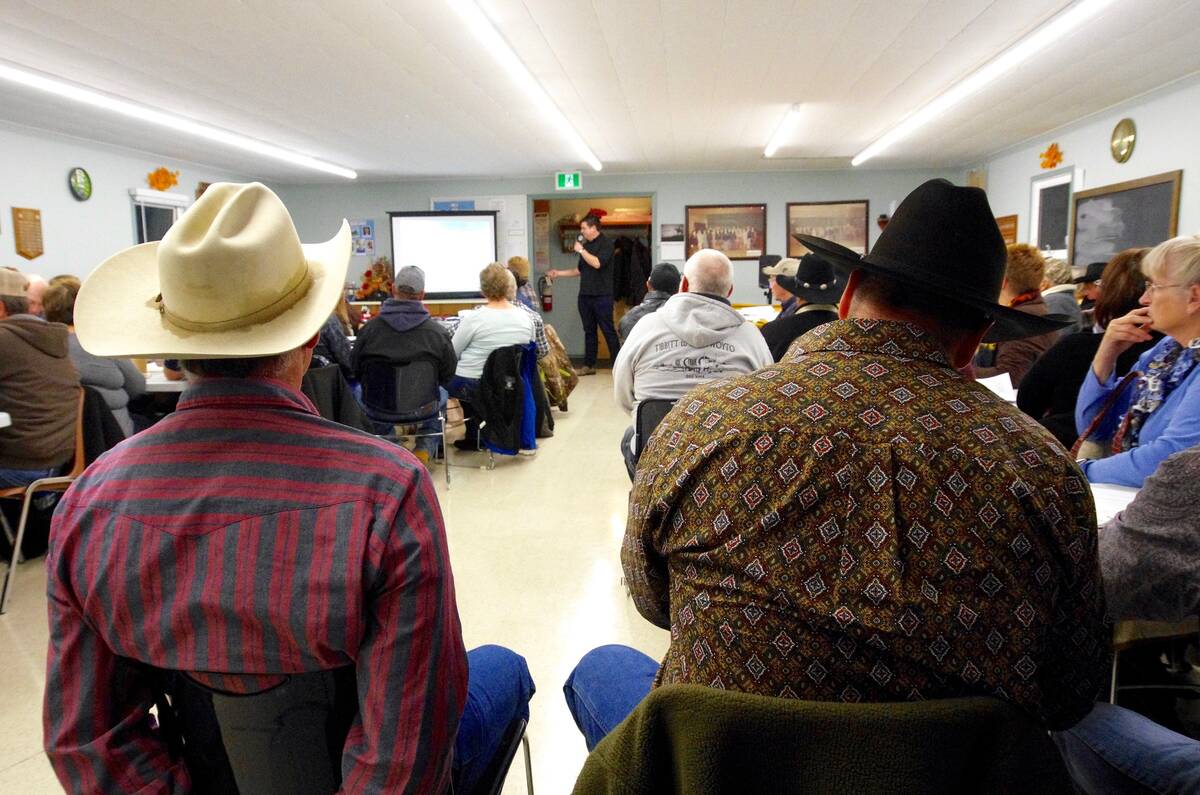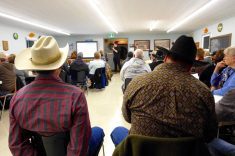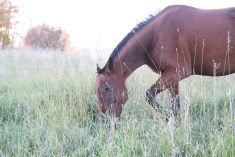Corn grazing at MBFI will see a few new species in the undergrowth, part of a project on intercropped corn grazing
For most of Manitoba’s cattle, it’s time to settle into the yard. The herd at Manitoba Beef and Forage Initiatives (MBFI) north of Brandon however, is getting ready to hit the cornfield.
Corn grazing itself is no surprise at MBFI. It’s how the applied research and demonstration farm, which has a goal of keeping cattle on the landscape year round, has typically overwintered its herd.
Newer, however, is what exactly is growing between those corn rows.
Is there a magic combination of plant species and row spacings that might take corn grazing in Manitoba to the next level? MBFI intends to find out.
Read Also

Don’t blow off that beef producer meeting
Local veterinarians and livestock experts often speak at beef producer group events. They have good advice for the farmer on vaccines, calving, beef herd management and more.
This year is the second that the farm has tried out intercropped corn grazing. The expanded project will see cattle graze both 30-inch and 60-inch corn rows this winter, both with and without intercrop. Last year’s project was limited to 30-inch row spacing.
The species list has also expanded. Last year, four forage species were intercropped with corn. This year, test strips are intercropped with a mix of winter triticale, two types of ryegrass, two types of clover, hairy vetch, forage rapeseed, plantain, chicory and tillage radish.
“Through that mix, each one of those plants does a slightly different thing,” MBFI general manager Mary Jane Orr said.
The idea, Orr said, is threefold. Intercropped corn may simply provide more forage for cattle to graze in the field, she noted. In addition, the farm is interested in any nutritional advantage the corn gets from being intercropped with other species, as well as whether the extra competition between corn rows might help beat back weeds.
Last year bust
While the crux of the project is a repeat of last year, the farm’s efforts to tease out definite results in 2019 ran up against the same freak snowstorm that derailed harvest. Intercrops were flattened by a thick layer of wet, heavy snow over the Thanksgiving weekend last year. That flattened forage ended up going to the local deer, Orr noted, that, unlike the cattle, were savvy enough to paw down through the snow.
“If they (the cows) did eat it, it wasn’t anything that we were able to observe,” Orr said.
Organizers hope this year will be different. While there was still snow on the ground Oct. 21, depths were a far cry from early October last year. Intercrops had several more weeks to add biomass than last year, project organizers pointed out, and the October snow was light enough that greenery was still poking out into the air between corn rows by the end of October.
Possible pros
While adding intercrops will hopefully add more forage for grazing, Orr is leery to suggest that it might actually decrease hay supplement needs for a corn grazing herd.
Consistent hay supplementation is key to the success of MBFI’s system. The typically high-energy, low-protein cornstalks must be so supplemented for a balanced ration. Feeding that hay just before a herd goes into a new paddock also ensures cattle are full of hay, and therefore less likely to gorge themselves on fresh corncobs, when they move.
“I haven’t seen yields, just eyeballing it, that would indicate that it would set up enough to provide the forage needed to balance the ration to prevent the risks of grain overload when you’re grazing corn,” Orr said. “I think the cows just need to have that full belly when they go into their next allocation.”
The farm will more than likely supplement hay at the same rate, regardless of the intercrop, she said. MBFI fences off strips for corn grazing based on fall yield estimates, the number of animals grazing and a percentage of cow body weight to determine dry matter requirements, she noted.
Instead, she said, she is more interested in the trends toward higher protein in corn noted last year, despite the other difficulties of the project. While cattle may not have got much uptake from the undergrowth between corn rows, analysis did show a slight trend towards more crude protein within the corn itself, something Orr is interested to explore more this winter.
“Corn grazing does have limitations in its protein content, depending on what gestation period the cow is in,” she said. “So can that corn, while it’s growing, get a bump from that intercrop in the below-ground network?”
More test strips this year will mean more data points, Orr noted, something she hopes will help smooth out field variability and better explore that relationship.
At the same time, she noted, there is currently small-plot work out of the University of Manitoba evaluating the value of intercropping with corn, which may also shed more light on MBFI’s observations.
The different row widths may also offer food for thought. Project organizers say they will be interested to see if wider rows impact grazing uptake of plants under the corn canopy. Intercrops in wider rows got more sunshine, something that might encourage more biomass, while the farm has yet to see if more room encourages cattle to find that lower feed more easily. At the same time, wider rows might decrease corn trampling, since cattle can better fit between the rows.
The project also hopes to gauge the impact on corn growth. Wider rows were double seeded, so that actual corn plant numbers remained the same as a 30-inch system. The thought, Orr said, was to maximize the field edge effect,
“Corn always grows more on the edge of the field because it has a whole side that isn’t competitive shading, so the idea is, if you take a row out, then you just have the edge effect everywhere,” she said.
On the other hand, Orr acknowledged, double seeding the rows also means more competition for nutrients and space.
“So how does that trade-off play out?” she said. “And then, with the intercropping side of things, it’s like, all of a sudden we’ve opened up the canopy. Can we get that productivity between the rows now that we weren’t getting?”
Work out of the United States, which the MBFI project was inspired by, have shown variable yield results.
The goal for MFBI, therefore, is finding the “magic combination” of intercrop species and corn species that might make the system hum, Orr noted.
Another, more grain-oriented goal, looks to weed control. The field chosen for the project this year had significant issues with millet and wild oats, Orr noted. Even plots without deliberately seeded intercrops have some amount of undergrowth forage, given the presence of those weeds. The goal, Orr said, is to gauge whether the competition provided by intercrops, might tamp down on those weeds.
“In fields where we’re having a lot of weed pressure, can we try and get something to grow that we want to grow, that we can manage more easily than, say, round-leaved mallow or wild oats or millet?” Orr said.
Taking stock
The project calls for MBFI staff to feed test and measure biomass for the various plots once plants become dormant for the winter, and prior to cattle turnout. Biomass between corn rows (including the “natural” weed intercrop), total field biomass and forage quality will all be recorded, Orr said.
“We’ll track that through and see just how much of a difference it (intercropping) makes and factor that into how many grazing days we get off of it,” she said.
The farm will also track forage uptake through residue sampling come spring.
Corn grazing caveats
FORAGE | Advocates will swear by the economics of corn grazing, but there are some best practices to keep in mind
Corn grazing looks attractive to the bank account, especially when feed prices are high, but producers should keep the risks in mind.
For those attracted to the practice, standing corn grazing promises high energy, high biomass and a low cost for wintering cattle. In 2011-12, research out of the Western Beef Development Centre in Lanigan, Sask., on five different corn varieties put corn grazing costs between 70 cents and $1.42 per head per day. Those numbers put the practice significantly below normal yardage costs, both academics and provincial extension staff commonly argue.
But the actual practice of corn grazing has always come with some cautions around grain overload, paddock moves and ration balance.
While high in energy, the practice is notably short on protein and calcium, Manitoba Beef and Forage Initiatives general manager Mary Jane Orr noted, something that makes supplementary hay critical.
The same Western Beef Development Centre study found an average 7.4 per cent protein in corn, researcher Bart Lardner has since presented, while 2015 data from the University of Saskatchewan put corn protein around 8.2 per cent.
At the same time, Manitoba’s provincial extension staff have warned producers to find the line between moving cattle too quickly, and thus not pressing them to clean up higher-fibre parts of the corn plant, and running out of feed on a paddock.
During a 2018 tour of corn grazing at MBFI, provincial livestock specialists urged producers to fence off only three to four days’ worth of corn at a time. Cattle coming into a new pasture will first fill up on cobs before moving on to husks, leaves and stalks, they noted, something that could risk grain overload.
“It’s the same when you’re grazing alfalfa,” Orr said. “You can graze them on alfalfa, but you still need to provide kind of a lower-quality forage that fills them up so that they don’t overload on that rocket fuel.”
For the same reason, producers are advised to time a hay meal directly before opening up the next section of cornfield. Cows will then fill up on hay and go into the new section, with its new supply of corncobs, without room to gorge. — A.S.
















